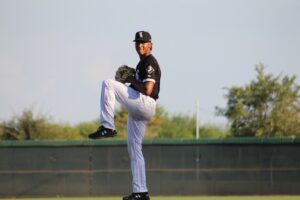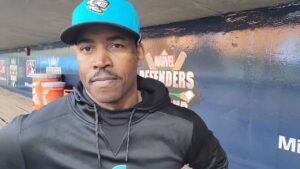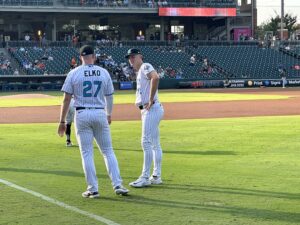Chicago White Sox Project Birmingham: By the Numbers
The Chicago White Sox made a decision no other Major League organization has ever done. In late August of 2022, the Sox selected a number of prospects to participate in what they called “Project Birmingham.” Members of the organization were challenged to compete in double-A, which was a level that forced White Sox prospects to compete against an average age gap of nearly two years their superior.
White Sox Assistant General Manager Chris Getz took charge of Project Birmingham and included in the mix was the No. 57 ranked prospect in MLB, Colson Montgomery. So, how’d it go?
BATS
Colson Montgomery
The White Sox number one prospect had a remarkable season, but ran out of gas in Birmingham. The 20-year-old out of Holland, Indiana, slashed .146/.192/.292 in 53 plate appearances. He struck out 28.8% of the time but smacked two home runs. The challenging assignment shouldn’t dampen expectations for the left-handed hitting shortstop.
Bryan Ramos
Another young player to join the Barons as part of Project Birmingham was the 20-year-old third baseman out of Cuba. In 86 plate appearances, Ramos slashed .225/.279/.375 and smacked three home runs. His numbers aren’t all negative. He struck out at an acceptable 17.4% clip with a 5.8% walk rate. Ramos remains a quality bat in the White Sox system, a top-5 prospect in the organization and good enough to earn a spot on the 40-man roster.
Wes Kath
A tough season in Low-A Kannapolis dropped the White Sox second-round pick in 2021 in our rankings, but it didn’t prevent him from getting a shot in Birmingham. The 19-year-old out of Scottsdale, Arizona, got to the dish 52 times in Birmingham, slashing .170/.250/.191 with a strikeout rate of 44%. It’s too early to give up on this young left-handed bat. His power and walk rate in Kannapolis provide reasons for optimism.
Luis Mieses
As a Project Birmingham call-up, the 6-foot-3 outfielder out of the Dominican played 23 games at Double-A. The left-hander slashed .299/.333/.443 with three home runs in 102 plate appearances.
While striking out at a respectable 19.6% clip, he put up a wRC+ of 104 and an ISO of .144. Splitting time between both corner outfield spots, the slender Mieses is an intriguing prospect who continues to fly under the radar.
Wilfred Veras
Being only 19 didn’t stop Chris Getz from making the third baseman a part of the project. Moving from Low-A Kannapolis to the Southern League is a sizeable jump. The magnitude of the leap didn’t overwhelm Veras, though.
In 48 plate appearances, the 6’2” right-hander out of the Dominican slashed .264/.313/.533 with three home runs. He struck out at approximately a 30% clip. His production at all levels this season was enough for him to be named the White Sox hottest hitting prospect by MLB Pipeline and an invitation to the Arizona Fall League.
DJ Gladney
The 6-foot-3 corner infielder showed prodigious power in Low-A Kannapolis, earning him a chance to hit Double-A pitching. At 20 years old, Gladney is highly regarded within the White Sox and he was challenged in Birmingham.
The right-handed hitter slashed .193/.207/.281 with a 39.7% strikeout rate. Gladney needs more opportunities to develop consistency in making contact. His athleticism and strength encourages observers to stay patient with this project.
Adam Hackenberg
After an impressive 2021 in Kannapolis, Hackenberg emerged as the top catching prospect in the White Sox system. Expectations have been dampened as he struggled offensively in High-A Winston-Salem.
However, his defense and pop at the plate is strong enough to carry him to the majors, warranting a spot in Project Birmingham. The 6’1 225 pounder out of Clemson got 46 plate appearances and slashed .167/.239/.262 with a 30% strikeout rate.
Though infrequent, Hackenberg can hit the ball a long way, as he smashed seven dingers for the Dash in 2022. He also walked at a 9.9% clip at High-A. With an Arizona Fall League assignment, it’s evident the White Sox are invested in the backstop’s development.
Tyler Osik
Tyler Osik can hit. The 2019 27th rounder put up a killer slash line at Winston-Salem of .310/.390/.463 with 10 home runs and a 21% strikeout rate. At nearly 26 years old, the 5-foot-10, 200-pounder out of Central Florida needs to produce in the upper minors. Project Birmingham was his aperture.
In 53 plate appearances, Osik slashed .200/.321/.356 with a 35.8% strikeout rate. On the positive side, he smashed two home runs and walked at an 11.3% clip. Given what he’s shown at the lower levels, he should get an opportunity to adjust in 2023.
ARMS
Norge Vera
Despite missing a good chunk of the season with a lat injury, Vera managed to spend time at three different levels in 2022. After tearing up Kannapolis, he struggled in his appearances at upper levels.
He started three games in Birmingham, covering eight innings. In the small sample, his WHIP was 2.13 with an ERA of 5.63. After walking 15 in 24 innings at Low-A Kannapolis, he issued 12 free passes and a matching 12 strikeouts in his time at Birmingham. Vera remains one of the more impressive arms in the system.
Cristian Mena
After dominating at Kannapolis in the early part of the season, the 6-foot-2, 170-pound right-hander out of the Dominican didn’t fare as well in stops at High-A Winston-Salem or in his late-season run in the Deep South.
In 11 starts in Kannapolis, Mena posted a 1.12 WHIP and a 2.68 ERA while striking out 66 in 53.2 innings. In Birmingham, Mena found less success with his big curveball and low 90s fastball.
His WHIP ballooned to 1.70 and his ERA to 6.30 in his three starts in the Southern League. At 19-years-old, Mena has plenty of time to develop his mechanics and gain velocity on his fastball.
Matthew Thompson
At age 22 and having lost what would have been his first full professional season in 2020 due to COVID, a Double-A assignment was considered aggressive for the 6’3” 195-pounder in 2022.
In seven Southern league starts and 25.1 innings, he struck out a whopping 31 batters against only 11 walks. It seems it was all or nothing for Thompson, as he allowed 15 earned runs and three long balls with a WHIP of 1.46. The White Sox made a significant financial investment in Thompson, so he’ll have plenty of opportunity to progress in 2023 and beyond.
Jared Kelley
After a bumpy professional debut in 2021, observers were concerned about the long-term viability of the 6-foot-3, 245-pound right-hander out of Texas. Kelley showed improvement in 2022, but not enough to allay fears that the White Sox may have squandered the $3 million signing bonus they paid him.
Kelley has enough raw stuff to earn him a shot in Birmingham, where he posted a 1.67 WHIP, a 4.50 ERA and struck out a batter an inning in 12 innings of work. Command and control are the biggest obstacles between Kelley and a big-league career.
Kohl Simas (See-Miss)
Signed as a free agent out of Fresno, CA in, 2021, the soon-to-be 23-year-old put up some eye-popping numbers in the lower minors. In 18 innings out of the bullpen in Kannapolis in 2021, he posted a .072 WHIP to go with 23 strikeouts. He followed that up with a 1.23 WHIP and 76 strikeouts in 61.2 innings as a starter in 2022.
Simas features a mid-90s fastball, two above-average breaking pitches and a decent changeup that could have him building on his father’s legacy as a member of the pitching staff in Chicago. To replicate his father’s big-league dreams, he’ll need to improve his performance at the upper levels of the minor leagues.
Despite the poor outcome, his six innings of work in double-A provided a valuable learning experience heading into what could be a massive leap for Simas in 2023.
Andrew Dalquist
Another signee out of high school who received a big bonus, Dalquist, also needs to make considerable improvements to reach the big leagues. Dalquist offers polished mechanics and a starter’s mix of pitches, but command continues to plague his MiLB career.
The results were no different in Birmingham, as he walked 11 in 11 innings of work. This translated into a 1.65 WHIP and a 3.38 ERA in four starts.
Summary
Collectively, the assignments to Project Birmingham appeared to be a bit too aggressive, with many players struggling. With adversity comes learning and growth. Perhaps these challenges will benefit the players in the future. For the handful of players that experienced success, the boost in confidence may fast-track them in their quest to become major leaguers. Either way, the jury is still out on Project Birmingham. It’ll likely take a few years to reach a verdict.







Happy Thanksgiving everyone. When was the last time the White Sox organization developed a halfway decent catcher? Was it Miguel Olivo or do you have to go all the way back to Ron Karkovice?
Narvaez has had a pretty good career. Flowers’ first hit AA with the Sox.
Too bad Narvaez was one of the worst framers in baseball until he went to Milwaukee.
I like the idea at least. Maybe giving players an idea of what competition is like a step or two above could give them more incentive to adopt changes suggested by the coaching staff (working on a shorter, simpler swing in the offseason, or whatever). And I think they sold it as having staff at AA to work with each of the players individually on plans/adjustments. It could not work, of course, but they haven’t been great at developing players recently anyway. Maybe it shows promise and 5 years down the road lots of MLB teams are doing it.
I think it was an inspired idea. When you haven’t had a ton of success developing players, why not look to try something different? We’ll see.
I have to admit I was not a fan of this. Most of these guys were woefully overmatched and I didn’t really see the benefit to them getting blown away like most of them did.
This could’ve been done to screw with other teams’ projection models. You take good performance at lower levels (well, good in some of these cases, some of them were pretty bad even in A-ball), along with the fact that the player reached AA, and some teams might have projection models that will have those particular players projected to debut at MLB level at an earlier age than they would have otherwise if they had just stayed in A- or A+. If the player is projected to debut in MLB earlier, their long-term projection will be better in those models.
Eric Longenhagen at Fangraphs has written about this before.